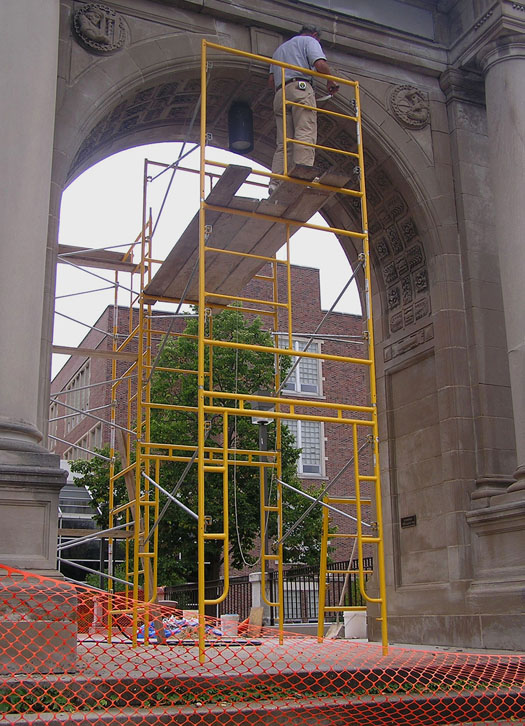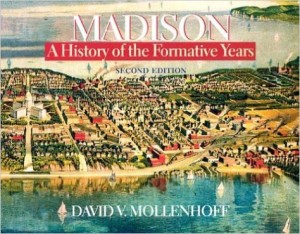A slightly different version of this post was originally published on the Madison Central High School History blog on January 1, 2008. It is a slightly longer version of a page-one feature story I wrote for The Wisconsin State Journal that was published on October 31, 2007 (with different photos). Despite the upbeat tone of the story, six years later more than a few people remain concerned about the future of the arch and MATC’s commitment to preserving it.- NG

Stonemason and sculptor Jacob Arndt working on the restoration of the Central High School arch in October 2007
A lone worker stood atop yellow scaffolding and began repairing the Central High arch on Wisconsin Avenue earlier this month. The sight brought sighs of relief from admirers of the arch, who noticed what seemed to be visible signs of structural disintegration this summer.
The arch is all that remains of the Cass Gilbert-designed Madison Central High School building torn down in 1986 to make room for a MATC parking lot. At that time, the arch was allowed to stand as a means of mollifying local preservationists, Central alumni, and the occasional fan of Gilbert, an architect whose works also include the Woolworth Building in New York City and the U.S. Supreme Court Building in Washington, D.C.
In 2002, a proposed development plan involving the Madison Children’s Museum threatened the arch. It survived because the Museum found another home.
However, many Central alumni and preservationists worried the arch’s increasingly fragile condition continued to pose a threat to its existence. Some, including Central alumnus Mark Pankow, tried unsuccessfully to organize a project committee to raise funds to pay for restoration of the arch or to move it to another location. Others feared that MATC, which owns the arch and the property on which it stands, was deliberately allowing the arch to disintegrate so it would eventually become unsafe and have to be torn down.
Now the worrying can cease and the conspiracy theories can be abandoned.
Jacob Arndt, the stonemason and sculptor who’s doing the repair and restoration work, says continued worry about the condition of the arch is unnecessary – and not just because of what he’s been doing for the past several weeks. “The arch is not delicate,” he says. “It’s robust and healthy: It just looks disheveled.” Furthermore, says Arndt, owner of Northwestern Masonry & Stone in Lake Mills, “With regularly scheduled routine maintenance these masonry buildings last forever: My partner, Gayal Oglesbay, and I own one in France that was built in the 15th century.”
Kelly Thompson, principal architect at Facility Engineering, Inc., the firm that sub-contracted the restoration work to Arndt, agrees. He says when his firm analyzed what work needed to be done on the arch for MATC, “We looked at it with our historic preservation glasses.” The firm’s assessment was that the structure was solid, not sinking, but needed to undergo routine maintenance.
Fred Brechlin, MATC Professional Services Manager-Facilities, says the current work being done on the Central High arch – including tuck pointing and making certain there are no loose bricks – is part of its regular 10-year maintenance program
“We’re maintaining the arch,” says Roger Price, MATC Vice President Infrastructure Services. “There’s been no discussion about moving it.”
One of the reasons the arch looked especially disheveled this summer was because white streaks were appearing on the stonework, particularly at the top of the arch. Arndt says the white streaks are salt deposits created by moisture leaking from the roof and pulling salts from the Portland cement used in the building. When the moisture evaporates, it deposits the salts on stonework.
Arndt says the maintenance work he’s doing will solve this problem by replacing the roofing material – currently a rubber membrane – atop the arch. He originally planned to use leaded copper and masonry, but Thompson says there are some concerns about copper discoloration of the bricks and stone, so he and Arndt are discussing alternatives before making a final decision.
The rubber membrane was a cheap and quick way for taking care of the problem for a few years, says Arndt. However, Douglas Maki, CEI, Asset Manager for Facility Engineering, says “Nowadays we would never specify using it, but for its time the skin was a pretty decent way to protect the roof.”
Arndt, who has created stonework and sculpture for the Minnesota State Capitol in St. Paul (another building designed by Cass Gilbert) and the British Museum in London, says he was eager to work on the restoration of the Central High arch because, “We didn’t want to see them tear it down because you don’t see this kind of exquisite fabrication any more.” He notes that the heads and faces on the arch are “excellent, world-class sculpture.”
But are the quality of the workmanship and the reputation of the architect enough to justify the continued existence of the arch? Five years ago, when it seemed likely the arch would have to come down to make way for a museum, City of Madison preservation planner Kitty Rankin told Isthmus reporter Melanie Conklin, “The only thing historic about the arch is that is used to be attached to a historic building.”
Since then, Rankin has changed her mind about the arch. “I don’t believe that any more,” she says when asked about the comment she made in 2002. It was telephone calls from Central alumni responding to her comment that persuaded her to reassess her original opinion. “For a lot of people who grew up in the Bush, much of their neighborhood is gone,” she says. “The arch is a reminder of their youth and a monument cherished by a lot of people.”
Central alumni from the 1940s, 1950s, and 1960s agree with Rankin that the arch is a reminder of their youth, but also believe it is historically significant not because it was designed by a pioneering architect, but because it represents both a bygone era in Madison history and a very unique institution.
“The Central High arch is the last remaining, nostalgic sign of where I went to school,” says Joan Severa (Class of 1943), retired Curator of Costume & Textiles for the Wisconsin Historical Society. She recalls that, “We took a lot of ribbing from kids at other schools because it was popular to be prejudiced and Central had so many Jews, Italians, and Blacks.” Like alumni from at least three decades, she still remembers the way students from other schools substituted ethnic and racial slurs for some of the lyrics of Central’s school song.
“The arch is a very valuable piece of history to me,” says Donald Gothard (Class of 1952), a retired electrical engineer who now lives in Michigan. One of the first Black electrical engineers to graduate from Notre Dame, Gothard worked on the guidance and navigation systems for the Apollo Lunar Landing Mission. During his senior year at Central, he served as student council president and remembers, “At that time Central was a very diverse school, but we were all working together harmoniously, not like East and West.”
Nils Olsen (Class of 1965), Dean and Professor of Law at the University at Buffalo Law School in New York, says, “The arch is a very nice monument to what was a very special place – a school that was small, diverse, and provided a great education.” Furthermore, he adds, “Central was an important institution in the city and it is only appropriate to have some testament to where it was.”
Sidney Iwanter (Class of 1967), an independent producer who lived in the Greenbush neighborhood and now lives in Los Angeles, says, “The arch is evocative of a portion of Madison that no longer exists except on microfiche. If you’ve moved to Madison recently and you walk down West Washington Avenue, you wouldn’t know that this was once a ghetto for Jews, Blacks, and Italians.” What makes the arch important, says Iwanter, is that, “It is a monument to a school that helped produce the American Dream for so many parents in Greenbush by serving as a feeder school to the University of Wisconsin.”
Judy Karofsky, a longtime Downtown Madison resident and activist, who not a Central alumna, says it was “pathetic” to save such a small piece of the Central High School Building, but she’s glad the arch survived. “At the beginning, it may have seemed frivolous, but the importance of the arch has increased over time,” she observes.
“The presence, size and elevation of the arch influences people as they walk by” says Arndt. “Beautiful architecture inspires a sense of worth that’s not there in today’s fabricated buildings.”
But if there seems to be a broad consensus that the Central High arch is something that should be maintained and preserved, why has it taken so long for routine maintenance to be performed? Terry Gulmire, who recently retired after 15 years as MATC’s facility director, says a 1999 exterior repair cost estimate for the Central High arch prepared by Angus-Young Associates, Inc. was $152,000. Repair of the arch was one of four projects MATC was considering and the high cost could not be justified, says Gulmire, because at that time the arch was deemed to have little historic significance.
The cost of the current maintenance work on the arch is $18,500, says Brechlin.
“One of the things we specialize in is historic structures,” says Maki. “They (MATC) have their priorities in place. The arch was up in the air. We provided a second opinion.”
A brief history of Madison Central High School
1854: Madison High School founded. First classes in the basement of a Methodist church
1858: School Board purchases the Female Academy on the site where the Central High arch now stands
1873: North wing of the “old building” replaces the academy
1877-78: South wing of the “old building” erected; “old building is occupied until 1906
1906-1908 – “Two years of wandering” (high school classes held in various buildings in Downtown Madison)
1908 – The new, Cass Gilbert-designed building built on the site of the “old building” opens its doors
1922: East High school opens and Madison High School is renamed Central High School
1930: West High School opens
1966: Wisconsin High School on the UW campus closes and merges with Central, which is renamed Central-University High School
1969: Last class graduates from Central-University High School; building subsequently becomes part of Madison Area Technical College
1986: Central-University High School building is demolished to make room for an MATC parking lot, but Wisconsin Avenue entry arch is left standing
Notable Central High School Alumni
Georgia O’Keeffe (attended 1902-1903) – Artist
Margaret H’Doubler (1906) – Credited with establishing, in 1926, the first dance education program at a U.S. university (at the University of Wisconsin)
Timothy Brown (1907) – Wisconsin Supreme Court Justice from 1949-1964 (Chief Justice 1962-1964)
Alfred Buser (1907) – Captain of the undefeated 1912 University of Wisconsin football team
John Hasbrouk van Vleck (1913) – Nobel Prize-winner in Physics
Wayne Lyman Morse (1919) – U.S. Senator from Oregon 1944-1969
Walter Frautschi (1920) – Madison businessman and philanthropist; father of John J. and W. Jerome “Jerry” Frautschi
John Bardeen (Class of 1923) – Only person to win the Nobel Prize for Physics twice
Edward Withers (1947) – All American defensive football player at the University of Wisconsin
Tracy Nelson (1963) – Blues and country singer
Notes: The links in the above text did not appear in my original copy, but were added for this post. My original copy had an error, which I have corrected here. Both my original copy and the story published in the Wisconsin State Journal stated that Donald Gothard graduated in 1953. He did not: He graduated in 1952. A sharp-eyed alumnus caught the error and contacted the newspaper, which subsequently printed a correction.






I wonder what will happen to the Central High arch when MATC rents the downtown land in a few years. Whoever rents it can do whatever they want to the building even tear it down.
Roger, if you’re on Facebook, you may want to have a look at the Save the Madison Central Arch page for updates and information about this issue: https://www.facebook.com/savethemadisoncentralhigharch/